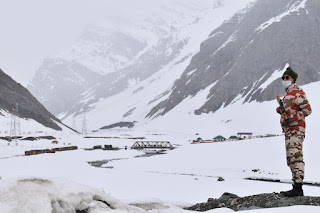India wants talks on Ladakh dispute but firm in its position
With no change in the positions of the Chinese and Indian troops at the Line of Actual Control (LAC) in Galwan valley and Pangong Tso areas of Ladakh, India has decided to lay emphasis on dispute resolution through talks.
Despite the strident tone set by Chinese President Xi Jinping on Tuesday commanding his troops to be prepared for war, Chinese ambassador to India Sun Weidong said that the two countries should seek understanding through communication. Weidong was addressing Indian youth over a webinar hosted by the Confederation of Young Leaders.
In Beijing’s true style, the tone has softened but not the intimidating situation on the border. And, in true Indian style, New Delhi too has been pursuing talks while maintaining forces at the border. India reminded the Chinese about the bilateral agreements signed between the two countries to resolve border issues. At the same time, India has ensured that senior officers on the border are in touch with their Chinese counterparts.
Ministry of External Affairs spokesperson Anurag Srivastava said yesterday that Indian troops take a responsible approach towards border management and strictly follow procedures laid out in bilateral agreements with China to resolve such issues.
“Our armed forces scrupulously follow the consensus reached by our leaders and the guidance provided,” he said, adding that India is committed to the objective of maintaining peace and tranquility in the border areas with China.
Since 1993, he said, India and China have signed several bilateral agreements and protocols to ensure peace and tranquility in the border areas. The two sides have established mechanisms at the military and diplomatic levels to resolve contentious issues on the India-China border, he added.
He also emphasized that even as India gives preference to talks, it remains firm in its resolve to protecting the country’s sovereignty and national security.
The current flare up has occurred as the Chinese are objecting to India constructing roads and bridges on the Indian side of the border to facilitate better movement of troops and vehicles. The stand-off is happening around the Galwan valley and the Pangong lake. Despite Chinese objections, India has not halted infrastructure development in the border areas.
Moreover, India has matched the Chinese deployment in terms of numbers of soldiers and has rapidly brought in reinforcements. It is reported that China has deployed about 5,000 troops on the border in Ladakh, which is evenly matched by the Indian side. The eyeball-to-eyeball confrontation began on May 5 when the troops from the two sides clashed, leaving many injured.
Taking note of the serious situation on the border, Prime Minister Narendra Modi met National Security Adviser Ajit Doval, Chief of Defence Staff General Bipin Rawat, and the three military chiefs. The Indian Army commanders’ meeting, which had been postponed due to the spread of coronavirus, too is happening at the same time.
Questions being raised are as to why is China playing so aggressively not just with India, but also with its other neighbors. In the last few months, it has tried taking on Vietnam, Malaysia, and the Philippines in the South China Sea. China is building pressure at a time when countries across the world are dealing with the devastating dual impacts of the coronavirus pandemic, which started from Wuhan, and the lockdowns.


Comments
Post a Comment